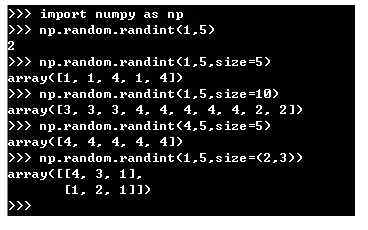标签:with 结果 hid href mamicode 语句 rand png exit
先来看看random.randint()方法:
import random for n in range(5): for i in range(10): print(random.randint(1,5),end=‘ ‘) print() #运行结果 1 5 5 3 3 1 3 1 5 2 4 4 4 4 4 4 3 1 5 2 3 2 3 1 1 5 5 1 4 3 3 4 4 2 5 5 3 4 4 4 3 5 4 5 4 5 4 5 2 4 Process finished with exit code 0
再来看看numpy.random.randint()方法
import numpy as np for n in range(5): for i in range(10): print(np.random.randint(1, 5), end=‘ ‘) print() #运行结果 2 4 1 1 1 1 2 2 2 4 3 4 3 2 3 4 3 2 2 4 2 2 1 2 1 1 3 3 3 4 4 1 4 2 4 1 3 4 3 2 2 3 3 2 3 4 4 3 4 4 Process finished with exit code 0
random.randint(a,b[,c]) #用于生成一个指定范围内的整数。其中参数a是下限,参数b是上限,生成的随机数n: a <= n <= b。c是步幅。
numpy.random.randint(low, high=None, size=None, dtype=‘l‘) #这个方法产生离散均匀分布的整数,这些整数大于等于low,小于high。 low : int #产生随机数的最小值 high : int, optional #给随机数设置个上限,即产生的随机数必须小于high size : int or tuple of ints, optional #整数,生成随机元素的个数或者元组,数组的行和列 dtype : dtype, optional #期望结果的类型

random.randint()与np.random.randint()的区别
标签:with 结果 hid href mamicode 语句 rand png exit
原文地址:https://www.cnblogs.com/insane-Mr-Li/p/13266145.html